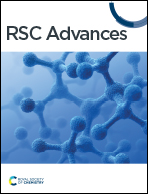Fabrication and application of glutathione biosensing SPCE strips with gold nanoparticle modification
Abstract
Glutathione (GSH) is a major antioxidant in organisms. An alteration in GSH concentration has been implicated in a number of pathological conditions. Therefore, GSH sensing has become a critical issue. In this study, a disposable strip used for tyrosinase-modified electrochemical testing was fabricated for the detection of GSH levels in vivo. The system is based on tyrosinase as a biorecognition element and a screen-printed carbon electrode (SPCE) as an amperometric transducer. On the tyrosinase–SPCE strips, the oxidation reaction from catechol to o-quinone was catalyzed by tyrosinase. The tyrosinase–SPCE strips were modified with gold nanoparticles (AuNPs). In the presence of AuNPs of 25 nm diameter, the cathodic peak current of cyclic voltammetry (CV) was significantly enhanced by 5.2 fold. Under optimized conditions (250 μM catechol, 50 mM phosphate buffer, and pH 6.5), the linear response of the tyrosinase–SPCE strips ranged from 31.25 to 500 μM GSH, with a detection limit of approximately 35 μM (S/N > 3). The tyrosinase–SPCE strips have been used to detect real samples of plasma and tissue homogenates in a mouse experiment. The mice were orally administrated with N-acetylcysteine (NAC) 100 mg kg−1 once a day for 7 days; the plasma GSH significantly enhanced 2.8 fold as compared with saline-treated mice (1123 vs. 480 μM μg−1 protein). NAC administration also could alleviate the adverse effect of GSH reduction in the mice treated with doxorubicin.



 Please wait while we load your content...
Please wait while we load your content...